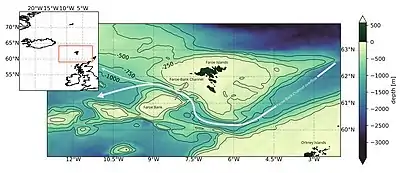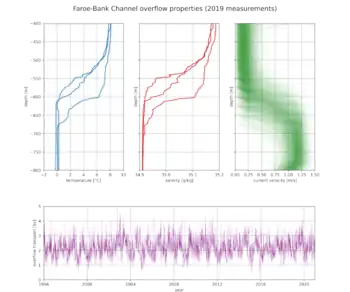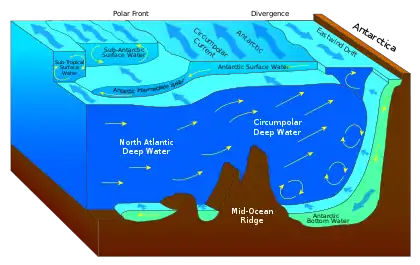Faroe-Bank Channel overflow
Cold and dense water from the Nordic Seas is transported southwards as Faroe-Bank Channel overflow. This water flows from the Arctic Ocean into the North Atlantic through the Faroe-Bank Channel between the Faroe Islands and Scotland. The overflow transport is estimated to contribute to one-third (2.1±0.2 Sv, on average) of the total overflow over the Greenland-Scotland Ridge.[1][2] The remaining two-third of overflow water passes through Denmark Strait (being the strongest overflow branch with an estimated transport of 3.5 Sv[3][4]), the Wyville Thomson Ridge (0.3 Sv), and the Iceland-Faroe Ridge (1.1 Sv).[1]

Faroe-Bank Channel overflow (FBCO) contributes to a large extent to the formation of North Atlantic Deep Water.[5] Therefore, FBCO is important for water transport towards the deep parts of the North Atlantic, playing a significant role in Earth's climate system.[6]
Faroe-Bank Channel
The Faroe-Bank Channel (FBC) is a deeply eroded channel in the Greenland-Scotland Ridge (GSR). Its primary sill, located south of the Faroe Islands, has a width of about 15 km and a maximum depth of 840 m, with very steep walls at both sides of the channel. 100 km north-west of this sill, there is a secondary sill with a maximum depth of 850 m.[7] Faroe-Bank Channel overflow enters the FBC from the northeast, turns towards the west between the Faroe Islands and the Faroe Bank, and leaves the GSR in southwestern direction, west-southwest of the Faroe Islands.[7]
Hydrography

The water flowing over the Greenland-Scotland Ridge through the Faroe-Bank Channel consists of a very well-mixed bottom layer, with a stratified water layer on top.[8] The temperature of this stratified layer can get to 11 °C in the upper 100 m of the channel, with a salinity around 35.1 g/kg; between 100 and 400 m depth the temperature of the water in the stratified layer is around 8 °C, with a salinity of 35.2 g/kg.[8] The water below 400 m, in the well-mixed layer, can be characterised as overflow water.
Definition of overflow
The mixed bottom layer of the FBC is where the actual overflow takes place, being fed by inflow of cold and fresh North Atlantic Water, Modified North Atlantic Water, Norwegian Sea Deep Water and Norwegian Sea Arctic Intermediate Water.[9] These water masses have different temperatures (between -0.5 and 7.0 °C) and salinities (between 34.7 and 35.4 g/kg).[9] Therefore, it may be complicated to exactly define which water entering the FBC contributes to the actual overflow. Four definitions are possible, two of which depending on the overflow velocity, one depending on the overflow flux, and one depending on the overflow water properties.
The simplest definition is in terms of velocities: water with a velocity in northwestern direction is then termed Faroe-Bank Channel overflow.[1] At the sill, velocites can grow up until 1.2 m/s, accelerating when flowing downwards the deepening bathymetry.[9] In this respect, high velocities are associated with strong mixing and highly turbulent flows. In the stratified layer at the top of the channel, velocities become negative (i.e., in southeastern direction), which makes these water no part of the overflow.
Another option is to take into account the barotropic (i.e., horizontal sea-surface height gradients determine currents) and baroclinic (i.e., horizontal density gradients determine currents) pressure gradients at the overflow depth between both sides of the GSR:
where is the decrease in sea-surface height and is the decrease in interface height from upstream areas to the sill.[10] Processes like mixing, circulation and convection contribute to these pressure gradients. The overflow velocity, then, scales as follows with the pressure gradient between the basins north and south of the ridge:
This velocity can then be used to define the total overflow flux in the FBC.[11] A third definition is so-called kinematic overflow: the water flux from the bottom of the channel up to the interface height, being the level where the velocity in northwestern direction measures one half of the maximum velocity in the profile.[10] The overflow flux is then calculated through
where is the average profile velocity, is the interface height, is the height of the layer below the lowest measurement station in the channel, and is the volume flux per unit width of the channel.[10]
Lastly, overflow can also be defined on the basis of hydrographical properties: namely as water that flows through the FBC having a temperature lower than 3 °C,[10] or having a potential density higher than 27.8 kg/m3.[12] This definition is most often used when estimating values for the magnitude of the FBCO.
Periodicity
Temperature and salinity profiles as well as current speeds in the FBC vary strongly on a day-to-day basis. The dense water forms domes that move through the channel with a period of 2.5 to 6 days.[2] At the ocean surface, this periodicity can be observed in the form of topographic Rossby waves at the sea surface, which are caused by mesoscale oscillations in the velocity field.[13] The resulting eddies are the consequence of baroclinic instabilities within the overflow water, which then induce the observed periodicity.[14]
On a greater timescale, atmospheric forcing also causes periodic changes in the FBCO. When the atmospheric circulation governing the Nordic Seas is in a cyclonic (anticyclonic) regime, the source of the deep water predominantly comes via a western (eastern) inflow path, and the FBCO will be weaker (stronger).[5] The eastern inflow path is called the Faroe-Strait Channel Jet. This transition from a cyclonic to an anticyclonic regime takes place on an interannual timescale, but the atmospheric forcing also shows a seasonal cycle. During summer the weakened cyclonic winds are associated with a higher FBCO transport. This indicates a fast barotropic response to the wind forcing.[5]
Outflow
Faroe-Strait Channel Jet water is much colder than the water flowing into the Faroe-Bank Channel via its western entrance path. Within the FBC, water always flows along its eastern rather than its western boundary, regardless the different inflow pathways from the Nordic Seas.[5] Moreover, at times the eastern inflow path is dominant, overflow waters are denser and higher in volume.
After passing the primary Faroe-Bank Channel sill, the overflow bifurcates into two different branches that both flow with a maximum velocity of 1.35 m/s on top of each other. The average thickness of the total outflow plume along its descent is 160±70 m, showing a high lateral variability, and yields a transport of ~1 Sv per branch.[15] A transverse circulation actively dilutes the bottom branch of the plume. The shallow, intermediate branch transports warmer, less dense outflow water along the ridge slope towards the west. This branch mixes with oxygen-poor, fresh Modified East Icelandic Water.[16] The deep (deeper than 1000 m) branch transports the most dense, cold water towards the deep parts of the North Atlantic.[17] This branch entrains warmer and more saline water, mixes, and consequently obtains higher temperatures and salinity. Both branches ultimately contribute to the formation of North Atlantic Deep Water.
North Atlantic overturning
The Atlantic meridional overturning circulation (AMOC) is important for Earth's climate because of its distribution of heat and salinity over the globe.[5] The strength of the Faroe-Bank Channel overflow is an important indicator for the stability of the AMOC, since the overflow produces dense waters that contribute for a large extent to the total overturning in the North Atlantic.[5] Parameters that can effect the AMOC are kinematic overflow (i.e., the magnitude of the overflow transport) and overflow density (as the AMOC being a density-driven circulation). In this respect, density characteristics of the overflow could vary even if the kinematic overflow does not.[10]
Measurements
From 1995 onwards, FBCO has been monitored by a continuous Acoustic Doppler current profiler (ADCP) mooring, measuring volume transport, hydrographic properties and the density of the overflow.[17] The kinematic overflow, derived from the velocity field, showed a non-significant positive linear trend of 0.01±0.013 Sv/yr between 1995 and 2015, whereas the coldest part of the FBCO warmed in that same period with 0.1±0.06 °C (which made density decrease), causing increasing transport of heat into the AMOC.[18] This warming, however, is accompanied by an observed salinity (and therefore density) increase, which results in no net change in density.[18]
Model simulations
Climate models have shown an overall decreasing trend in the baroclinic component of the overflow between 1948 and 2005; the barotropic pressure gradient, however, shows an increasing trend of equal magnitude. These processes compensate each other; as a result the pressure difference at depth does not show a significant trend over time.[11]
Global inverse modelling, ocean hydrographic surveys, chlorofuorocarbon (CFC) inventories, and monitoring of the AMOC from 2004 to present have shown that the AMOC has slowed down in the past decades.[6] As explained, density of FBCO waters did not significantly change in that time period, so changes in FBCO cannot (fully) explain the changes in the AMOC.[19]
References
- Østerhus, Svein; Sherwin, Toby; Quadfasel, Detlef; Hansen, Bogi (2008), "The Overflow Transport East of Iceland", Arctic–Subarctic Ocean Fluxes, Dordrecht: Springer Netherlands, pp. 427–441, doi:10.1007/978-1-4020-6774-7_19, ISBN 978-1-4020-6773-0, retrieved 2022-03-19
- Ullgren, J. E.; Darelius, E.; Fer, I. (2015-10-07). "Volume transport and mixing of the Faroe Bank Channel overflow from one year of moored measurements". Ocean Science Discussions. 12 (5): 2315. Bibcode:2015OcScD..12.2315U. doi:10.5194/osd-12-2315-2015.
- Jochumsen, Kerstin; Quadfasel, Detlef; Valdimarsson, Heðinn; Jónsson, Steingrímur (December 2012). "Variability of the Denmark Strait overflow: Moored time series from 1996-2011". Journal of Geophysical Research: Oceans. 117 (C12): n/a. Bibcode:2012JGRC..11712003J. doi:10.1029/2012jc008244. ISSN 0148-0227.
- Harden, B.E.; Pickart, R.S.; Valdimarsson, Héðinn; Våge, Kjetil; de Steur, Laura; Richards, Clark; Bahr, Frank; Torres, Dan; Børve, Eli; Jónsson, Steingrímur; Macrander, Andreas (June 2016). "Upstream sources of the Denmark Strait Overflow: Observations from a high-resolution mooring array". Deep Sea Research Part I: Oceanographic Research Papers. 112: 94–112. Bibcode:2016DSRI..112...94H. doi:10.1016/j.dsr.2016.02.007. hdl:1956/16720. ISSN 0967-0637.
- Barbara, Chafik, Léon Hátún, Hjálmar Kjellsson, Joakim Larsen, Karin Margretha H. Rossby, Thomas Berx (2020-07-24). Discovery of an unrecognized pathway carrying overflow waters toward the Faroe Bank Channel. Nature Research. OCLC 1286412816.
{{cite book}}: CS1 maint: multiple names: authors list (link) - Cheng, Wei; Chiang, John C. H.; Zhang, Dongxiao (15 September 2013). "Atlantic Mericional Overturning Circulation (AMOC) in CMIP5 Models: RCP and Historical Simulations". Journal of Climate. 26 (18): 7187–7197. Bibcode:2013JCli...26.7187C. doi:10.1175/JCLI-D-12-00496.1. S2CID 56001197.
- Beaird, Nicholas; Fer, Ilker; Rhines, Peter; Eriksen, Charles (2012-12-01). "Dissipation of Turbulent Kinetic Energy Inferred from Seagliders: An Application to the Eastern Nordic Seas Overflows". Journal of Physical Oceanography. 42 (12): 2268–2282. Bibcode:2012JPO....42.2268B. doi:10.1175/jpo-d-12-094.1. hdl:1956/16275. ISSN 0022-3670.
- Fer, Ilker; Voet, Gunnar; Seim, Knut S.; Rudels, Bert; Latarius, Katrin (January 2010). "Intense mixing of the Faroe Bank Channel overflow". Geophysical Research Letters. 37 (2): n/a. Bibcode:2010GeoRL..37.2604F. doi:10.1029/2009gl041924. ISSN 0094-8276. S2CID 129748007.
- Borenäs, Karin; Lundberg, Peter (2004-02-01). "The Faroe-Bank Channel deep-water overflow". Deep Sea Research Part II: Topical Studies in Oceanography. The Physical Oceanography of Sea Straits. 51 (4): 335–350. Bibcode:2004DSRII..51..335B. doi:10.1016/j.dsr2.2003.05.002. ISSN 0967-0645.
- Hansen, Bogi; Østerhus, Svein (December 2007). "Faroe Bank Channel overflow 1995–2005". Progress in Oceanography. 75 (4): 817–856. Bibcode:2007PrOce..75..817H. doi:10.1016/j.pocean.2007.09.004. ISSN 0079-6611.
- Olsen, Steffen M.; Hansen, Bogi; Quadfasel, Detlef; Østerhus, Svein (September 2008). "Observed and modelled stability of overflow across the Greenland–Scotland ridge". Nature. 455 (7212): 519–522. Bibcode:2008Natur.455..519O. doi:10.1038/nature07302. ISSN 0028-0836. PMID 18818655. S2CID 4383230.
- Huang, Jie; Pickart, Robert S.; Huang, Rui Xin; Lin, Peigen; Brakstad, Ailin; Xu, Fanghua (2020-10-23). "Sources and upstream pathways of the densest overflow water in the Nordic Seas". Nature Communications. 11 (1): 5389. Bibcode:2020NatCo..11.5389H. doi:10.1038/s41467-020-19050-y. ISSN 2041-1723. PMC 7584654. PMID 33097701.
- Darelius, E.; Ullgren, J. E.; Fer, I. (2013-07-01). "Observations of Barotropic Oscillations and Their Influence on Mixing in the Faroe Bank Channel Overflow Region". Journal of Physical Oceanography. 43 (7): 1525–1532. Bibcode:2013JPO....43.1525D. doi:10.1175/jpo-d-13-059.1. hdl:1956/13066. ISSN 0022-3670.
- Guo, Chuncheng; Ilicak, Mehmet; Fer, Ilker; Darelius, Elin; Bentsen, Mats (2014-10-01). "Baroclinic Instability of the Faroe Bank Channel Overflow*". Journal of Physical Oceanography. 44 (10): 2698–2717. Bibcode:2014JPO....44.2698G. doi:10.1175/jpo-d-14-0080.1. ISSN 0022-3670. S2CID 129512851.
- Nicholas, Ullgren, Jenny E. Fer, Ilker Darelius, Elin Beaird (2014-04-09). Interaction of the Faroe Bank Channel overflow with Iceland Basin intermediate waters. John Wiley & Sons. OCLC 1130872761.
{{cite book}}: CS1 maint: multiple names: authors list (link) - Ullgren, Jenny E.; Fer, Ilker; Darelius, Elin; Beaird, Nicholas (January 2014). "Interaction of the Faroe Bank Channel overflow with Iceland Basin intermediate waters". Journal of Geophysical Research: Oceans. 119 (1): 228–240. Bibcode:2014JGRC..119..228U. doi:10.1002/2013jc009437. hdl:1912/6540. ISSN 2169-9275.
- Beaird, N. L.; Rhines, P. B.; Eriksen, C. C. (2013-11-01). "Overflow Waters at the Iceland–Faroe Ridge Observed in Multiyear Seaglider Surveys". Journal of Physical Oceanography. 43 (11): 2334–2351. Bibcode:2013JPO....43.2334B. doi:10.1175/jpo-d-13-029.1. ISSN 0022-3670.
- Hansen, Bogi; Húsgarð Larsen, Karin Margretha; Hátún, Hjálmar; Østerhus, Svein (2016-11-17). "A stable Faroe Bank Channel overflow 1995–2015". Ocean Science. 12 (6): 1205–1220. Bibcode:2016OcSci..12.1205H. doi:10.5194/os-12-1205-2016. ISSN 1812-0784.
- S.A., Bryden, H.L. Longworth, H.R. Cunningham (2005). Letter. Slowing of the Atlantic meridional overturning circulation at 25° N. OCLC 921259324.
{{cite book}}: CS1 maint: multiple names: authors list (link)

